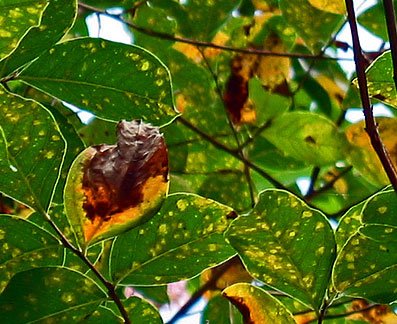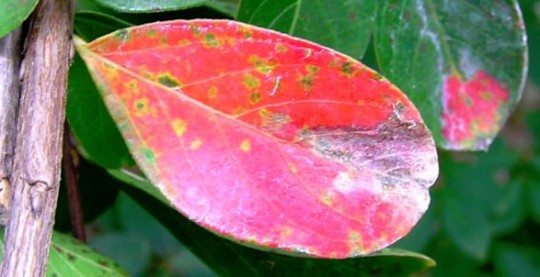Weekend Gardening: Spots On Your Crape Myrtles Can Be A Problem
July 29, 2017
by UF/IFAS Extension Service
As the heat and humidity increases in Northwest Florida, expect to see some diseases appear in the landscape. One problem that is popping up on crape myrtles is Cercospora leaf spot. While not a deadly problem, it can greatly detract from the beauty of crape myrtles.
The initial symptom on crape myrtles is the appearance of tan to dark brown spots randomly scattered on yellow to red discolored leaves. The spots develop first on the lower leaves and progress upward in the canopy. Spots will continue to develop from mid-summer through fall. The color change is due to the production of a toxin by the fungal pathogen.
Infected leaves will drop prematurely and serve as a source to spread the pathogen causing further disease development. As the summer progresses, many infected trees will have dropped all but the newest leaves.
Older varieties of crape myrtles are more susceptible to this disease than newer varieties. The crape myrtle varieties most tolerant to Cercospora leaf spot are Natchez, Muskogee, Basham’s Party Pink, Sioux and Tonto.
Long term, this disease is not detrimental to a tree, although it will slow down growth on younger plants. Plants growing in conditions that are not ideal will be more affected by the leaf spot disease.
The best control is selecting a planting site with good air circulation so that the foliage will dry quickly. Thinning interior branches will also promote air flow.
 The use of fungicides to control this disease has not been very effective because they would have to be applied repeatedly on a regular basis throughout the growing season. If used, fungicide applications should be started in early summer when the spots are first noticed and continued at one to two week intervals when the weather is warm and wet. Consult your local Extension office for fungicide recommendations.
The use of fungicides to control this disease has not been very effective because they would have to be applied repeatedly on a regular basis throughout the growing season. If used, fungicide applications should be started in early summer when the spots are first noticed and continued at one to two week intervals when the weather is warm and wet. Consult your local Extension office for fungicide recommendations.
As always, be sure to read and follow all label directions. Fungicides can be classified by how they work on the fungus or how they work on the plant. Products that work in a similar way on fungi have the same mode of action (also referred to as chemical family or class).
Contact fungicides are sprayed onto plants and act as a protective barrier from pathogen infection. They prevent infections from occurring when applied before symptoms are visible, but infections that have already occurred will continue to develop.
Systemic fungicides move into the plant, but movement inside the plant is limited. The vast majority of fungicides only move upward in the plant vasculature, but not down. Some fungicides only move locally into the plant part treated. Some systemic products exhibit curative action, which means the disease is stopped during its development. For managing fungicide resistance, products with different modes of action should be used in rotations.
Since this disease will result in early defoliation or the loss of leaves, it is critical to practice good sanitation. Raking and destroying fallen leaves should be a routine practice in order to prevent the spread of the disease.




Comments